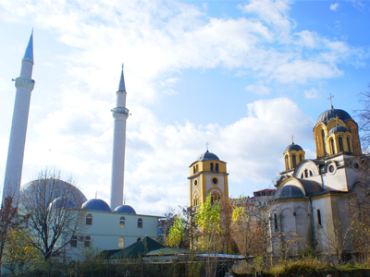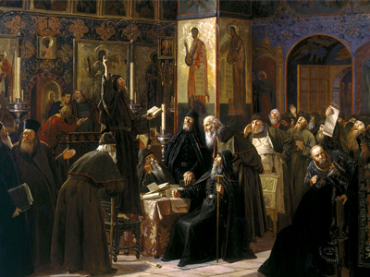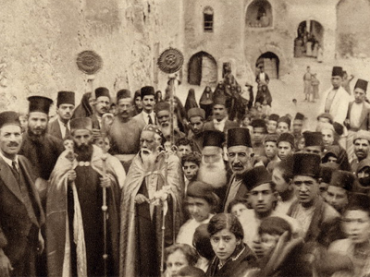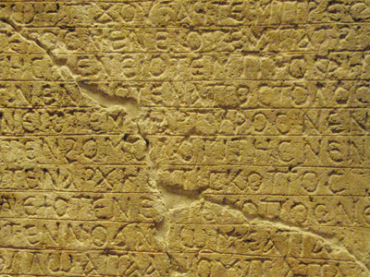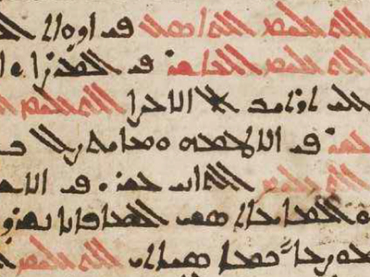Syriac and Eastern Christianity
Hugoye - Journal of Syriac Studies (volume 13)
2010 [2011]
Series: Hugoye: Journal of Syriac Studies 13
ISBN: 978-1-60724-921-4
Widely regarded as a premier journal dedicated to the study of Syriac, Hugoye: Journal of Syriac Studies was established in 1998 as a venue devoted exclusively to the discipline. An organ of Beth Mardutho, the Syriac Institute, the journal appears semi-annually and will be printed in annual editions. A peer-reviewed journal, Hugoye is a respected academic source for up-to-date information about the state of Syriac studies and for discovering what is going on in the field. Contributors include some of the most respected names in the world of Syriac today.
$75.00
Denkmäler der Entstehungsgeschichte des byzantinischen Ritus
Series: Analecta Gorgiana 467
ISBN: 978-1-60724-922-1
Anton Baumstark surveys key developments in the Byzantine liturgical rite and attempts to view these developments within the historical circumstances that likely affected or caused them.
$38.00
Die Marienharfe (Arganona Weddase)
Translation and Introduction by Sebastian Euringer
Series: Analecta Gorgiana 468
ISBN: 978-1-60724-923-8
Sebastian Euringer publishes here a German translation of the Ethiopic text of a grand poem dedicated to the Virgin Mary from the “monophysite” tradition. Euringer accompanies the translation with an introduction and critical notes.
$77.00
Die Rangordnung der Bischöfe Ägyptens
Nach einem Protokollarischen Bericht des Patriarchen Kyrillos ibn Laklak
Edited and Translated by Georg Graf
Series: Analecta Gorgiana 469
ISBN: 978-1-60724-924-5
Georg Graf publishes here the Arabic text and German translation of a “protocol report” by Cyril ibn Laklak, an important historical source for the study of the life of Cyril and for the history of Egyptian bishops.
$39.00
Die Manichäische Zarathustra-Hymne M7
Edited with an Introduction by Isidor Scheftelowitz
Series: Analecta Gorgiana 470
ISBN: 978-1-60724-925-2
In the present article, Isidor Scheftelowitz challenges the conclusions of Richard Reitzenstein that a Manichaean hymn fragment contained influences from the old Iranian religious system by offering a new translation and texts for comparison.
$36.00
Die mittelalterliche Überlieferung des Psalterium iuxta Hebraeos von Hieronymus und semitische Kennt
Series: Analecta Gorgiana 471
ISBN: 978-1-60724-926-9
Arthur Allgeier presents a survey of medieval translations of the Psalms in comparison with the translations of Jerome’s Psalterium iuxta Hebraeos in order to contrast the use of the underlying Hebrew text in the translation.
$38.00
Die Enjanehirmen der berliner Handschrift Sach. 349
Series: Analecta Gorgiana 472
ISBN: 978-1-60724-927-6
Odilo Heiming publishes here the Syriac text and German translation of eighty brief Syriac hymns (enjane) that were not included in Jules Jeannin’s Mélodies liturgiques syriennes et chaldéennes.
$39.00
Byzantinische Troparia und Kontakia in Syro-Melchitischer Überlieferung
Series: Analecta Gorgiana 473
ISBN: 978-1-60724-928-3
Joseph Molitor traces the influence of Byzantine troparia and kontakia (hymns) in the Syriac Melkite tradition as evidenced by several Syriac manuscripts. Molitor provides a thorough introduction and publishes the Syriac text and German translation for the hymns he surveys.
$50.00
St. Peter in Gallicantu
By A.M. Schneider & P. Power
Series: Analecta Gorgiana 474
ISBN: 978-1-60724-929-0
In the first of two articles published here together, A.M. Scheneider challenges the work of P. Power on the location of the house of Caiphas at the church of St. Peter in Gallicantu, and in the second article Power responds.
$40.00
Homélie de Narsès sur les trois Docteurs Nestoriens
Edited and Translated by Paulin Martin
Series: Analecta Gorgiana 475
ISBN: 978-1-60724-931-3
In this work, Martin offers the Syriac text, with an annotated French translation, of Narsai’s poem on the three doctors of the Church of the East: Diodore of Tarsus, Theodore of Mopsuestia, and Nestorius.
$57.00
Analecta Sacra Patrum Antenicaenorum ex Codicibus Orientalibus
Syriac and Armenian Fragments of Ante-Nicene Writings
Edited and Translated by Jean-Baptiste François Pitra; In Collaboration With Paulin Martin
Series: Syriac Studies Library 49
ISBN: 978-1-60724-932-0
This work contains a large number of Syriac and Armenian fragments from Ante-Nicene writings, with a translation into Latin and four indices: biblical passages, place names, persons, and subjects.
$220.00
Synodicon Orientale
Recueil de synodes nestoriens
Edited and Translated by Jean-Baptiste Chabot
Series: Syriac Studies Library 50
ISBN: 978-1-60724-933-7
This large volume, the essential resource for studying the official doctrine of the Church of the East from the fifth to eighth centuries, contains the Syriac texts, with a heavily annotated French translation, of synods from 410 to 775.
$258.00
Stilmittel bei Afrahat dem persischen Weisen
By Leo Haefeli
Series: Syriac Studies Library 51
ISBN: 978-1-60724-934-4
Drawing on the more progressed fields of Greek and Roman and Arabic rhetoric, Haefeli here presents Aphrahat’s style in terms of numerous stylistic categories. Naturally, the work is brimming with examples (in Syriac and German) from Aphrahat.
$138.00
Seine Person und sein Verständnis des Christentums
Ein Beitrag zur Geschichte der Kirche im Osten
By Paul Schwen
Series: Syriac Studies Library 52
ISBN: 978-1-60724-935-1
In this important study, still a standard resource on Aphrahat, Schwen deals with that writer’s life, works, and doctrine. It will be of certain use for students of Syriac literature and early Syriac Christianity.
$129.00
Aristoteles bei den Syrern vom V.-VIII. Jahrhundert
Series: Syriac Studies Library 53
ISBN: 978-1-60724-936-8
In this volume, Baumstark deals with the transmission of Aristotelian philosophy into Syriac and Arabic. Syriac texts with German translations are included, alongside a detailed study of their textual interrelationships.
$172.00
Histoire Complète de Joseph
Poème en douze livres
Edited with an Introduction by Paul Bedjan
Series: Syriac Studies Library 54
ISBN: 978-1-60724-937-5
Bedjan here presents the Syriac text, in vocalized East Syriac script, of a lengthy and highly praised poem (sometimes attributed to Ephrem, sometimes to Balai) on the Joseph story. An appendix contains a poem on the translation of Joseph’s bones.
$181.00
Traité de Grammaire Syriaque
By Rubens Duval
Series: Syriac Studies Library 55
ISBN: 978-1-60724-938-2
Duval’s thorough Syriac grammar takes its place beside Nöldeke’s “compendious” grammar as a standard resource for every student and scholar of Syriac.
$205.00
The Syriac Version of Cyril of Alexandria's Commentary on Luke
Edited with an Introduction by Robert Payne Smith
Series: Syriac Studies Library 56
ISBN: 978-1-60724-939-9
Payne Smith here gives an edition, prefaced by a helpful introduction (in Latin), of the Syriac translation of Cyril of Alexandria’s interpretation of Luke’s Gospel, which is incomplete in Greek.
$207.00
Titus of Bostra's Contra Manichaeos in Syriac
Edited by Paul Anton de Lagarde
Series: Syriac Studies Library 57
ISBN: 978-1-60724-940-5
From an early manuscript dated to 411 Lagarde here produces the text of the Syriac version of Titus of Bostra’s (died 371) Against the Manichaeans, which has not survived complete in Greek.
$135.00
The Pseudo-Clementine Recognitions and Homilies (10-14) in Syriac
Edited with an Introduction by Paul Anton de Lagarde
Series: Syriac Studies Library 58
ISBN: 978-1-60724-941-2
From two manuscripts, Lagarde has produced the text of the Syriac version of the Pseudo-Clementine Recognitions and Homilies (10-14). The Recognitions had also been translated into Latin, and Lagarde provides a concordance for the two translations.
$168.00
Georgs des Araberbischofs Gedichte und Briefe
Aus dem Syrischen übersetzt und erläutert
Translated and Annotated by Viktor Ryssel
Series: Syriac Studies Library 59
ISBN: 978-1-60724-942-9
Ryssel here offers a German translation of a variety of works from George, Bishop of the Arabs (died 724). Included here are poems on monasticism and the chrism, and several letters dealing with a variety of topics, with commentary.
$151.00
Le Livre d'Héraclide de Damas
Traduit en Francais
Translation and Introduction by François Nau
Series: Syriac Studies Library 60
ISBN: 978-1-60724-943-6
Nau gives here a heavily annotated French translation of the Syriac version of Nestorius’s lost Greek work called The Book of Heraclides, a lengthy defense and description of his christological position, along with a few shorter texts.
$196.00
Des Isho'dad von Maru Kommentar zum Hohenlied
Edited and Translated by Sebastian Euringer
Series: Analecta Gorgiana 476
ISBN: 978-1-60724-944-3
Sebastian Euringer publishes here the Syriac text of Isho’dad of Merv’s commentary on the Song of Songs accompanied by an introduction, a German translation of the commentary, notes on the translation, and parallels from other commentaries.
$36.00
Die zwölf Marka-Hymnen aus dem "Defter" der samaritanischen Liturgie
Translation and Introduction by Paul Kahle
Series: Analecta Gorgiana 477
ISBN: 978-1-60724-945-0
Paul Kahle publishes here a German translation, with critical notations, of twelve Aramaic Marka hymns, which are an important piece in the early Samaritan liturgy. Kahle’s work supplements other works that contain the Aramaic texts by providing a modern translation.
$37.00
Die äthiopische Überlieferung der Abhandlung des Evagrius "Über die acht Gedanken"
Edited with an Introduction by Otto Spies
Series: Analecta Gorgiana 478
ISBN: 978-1-60724-946-7
Otto Spies publishes here a critical apparatus with variant readings to supplement Johannes Bachmann’s edition of the Ethiopic version of the work “concerning the eight [sinful] thoughts” by Evagrius of Pontus. Spies provides a German translation of the collated text.
$36.00
Filter by
Filter by price
Filter by manufacturer

